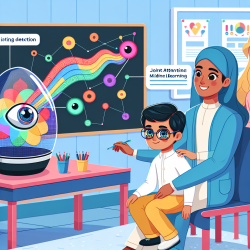Discover the Magic of Eye-Tracking in Autism Detection
As a special education director, staying informed about the latest advancements in autism research is crucial. A recent study titled Machine learning for distinguishing Saudi children with and without autism via eye-tracking data has unveiled promising insights into using eye-tracking technology for autism detection. This blog will guide you through the key findings and encourage you to explore further research opportunities.
Understanding the Study
The study focused on Saudi children and utilized eye-tracking technology to identify gaze patterns associated with Autism Spectrum Disorder (ASD). The researchers aimed to develop machine learning models that could effectively classify children with and without autism based on these patterns.
Key Findings
- Reduced Left Visual Field Bias: Children with autism showed a reduced tendency to focus on the left side of faces, both human and animal, indicating a diminished left visual field (LVF) bias.
- Joint Attention Challenges: Autistic children exhibited slower response times and shorter dwell times on objects during joint attention tasks, highlighting difficulties in reflexive joint attention.
- Machine Learning Success: The random forest algorithm emerged as the most effective model, achieving an accuracy of 76% in classifying ASD based on eye-tracking data.
Implications for Practitioners
These findings present exciting opportunities for practitioners in the field of special education:
- Enhanced Screening: Incorporating eye-tracking technology into screening processes can offer a non-invasive and objective method for early autism detection.
- Targeted Interventions: Understanding specific gaze patterns can help tailor interventions that focus on improving joint attention and social communication skills.
- Further Research: This study opens the door for further exploration into the use of eye-tracking as a biomarker for autism, particularly in under-researched regions.
Encouraging Further Exploration
While the study offers promising results, it also highlights the need for continued research. Practitioners are encouraged to explore the potential of eye-tracking technology in their own settings and contribute to the growing body of knowledge in this field.
To read the original research paper, please follow this link: Machine learning for distinguishing saudi children with and without autism via eye-tracking data.










